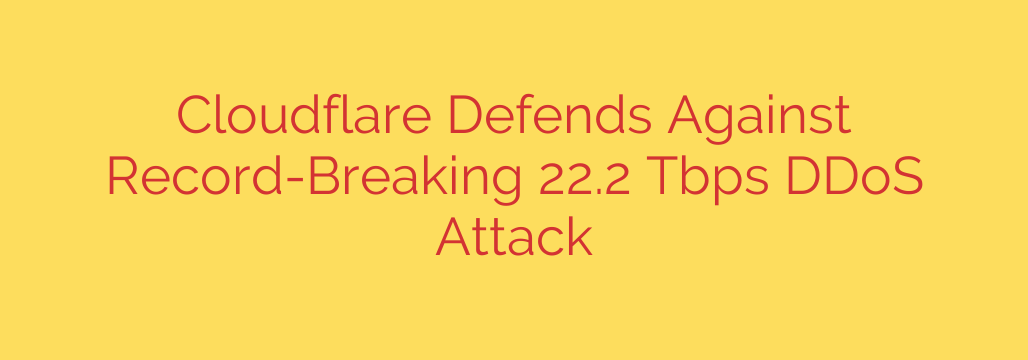
Anatomy of a Record-Breaking DDoS Attack: Inside the 22.2 Tbps Cyber Onslaught
The world of cybersecurity is a relentless arms race, and the latest battle has set a new, alarming benchmark. Security provider Cloudflare recently confirmed it successfully mitigated a record-breaking 22.2 Tbps (terabits per second) Distributed Denial of Service (DDoS) attack, the largest ever recorded in terms of data volume. This colossal assault highlights the escalating power of threat actors and the critical importance of robust defense systems in protecting our digital infrastructure.
This wasn’t just another attack; it was a stunning display of force. To put 22.2 Tbps into perspective, it’s a torrent of malicious data equivalent to downloading over 5,000 full-length HD movies every single second. The attack was launched by a sophisticated and powerful botnet, showcasing the new generation of tools available to cybercriminals.
The Attack: A Short, Violent Burst
The assault was characterized by its immense scale and surgical precision. Launched by a botnet known as “Mantis,” the attack was a multi-vector onslaught, meaning it used several techniques simultaneously to try and overwhelm the target’s defenses.
Unlike older botnets that relied on millions of low-power Internet of Things (IoT) devices like smart cameras, Mantis operates differently, hijacking powerful virtual machines and servers. This gives each “bot” in its network significantly more firepower, allowing the botnet to generate massive attack traffic from a relatively small number of compromised machines—in this case, just over 5,000 devices.
Key details of the attack include:
- Massive Volume: Peaking at 22.2 terabits per second.
- High Request Rate: The botnet also generated over 330 million malicious requests per second at its peak.
- Targeted Victim: The attack was aimed at a Cloudflare customer operating in the cryptocurrency industry, a sector frequently targeted by such attacks.
- Automated Defense: The entire onslaught was detected and blocked automatically by Cloudflare’s autonomous systems, preventing any impact on the target’s services.
This event demonstrates a clear trend: DDoS attacks are becoming more powerful, more sophisticated, and can be launched with terrifying speed. The barrier to entry for launching massive cyber attacks has never been lower, and the potential for disruption has never been higher.
The Evolving Threat: Why Are Attacks Getting Bigger?
The rise of hyper-scale DDoS attacks is fueled by several factors. The primary driver is the evolution of botnets from simple compromised devices to hijacked cloud infrastructure. By leveraging the immense computing power and bandwidth of data centers, attackers can generate unprecedented volumes of traffic.
Furthermore, the “DDoS-for-hire” market continues to thrive on the dark web, allowing individuals with little technical skill to rent powerful botnets like Mantis to launch attacks for a surprisingly low cost. This commoditization of cybercrime tools means any organization, large or small, can become a target.
How to Protect Your Organization from Modern DDoS Attacks
While fending off a 22.2 Tbps attack is beyond the capability of most individual organizations, the principles of good cyber defense remain crucial. Businesses must adopt a proactive, multi-layered security posture to mitigate the risk of disruption.
Here are essential steps to enhance your organization’s resilience:
- Employ a Professional DDoS Mitigation Service: The scale of modern attacks requires specialized, cloud-based protection. These services are designed to absorb and filter massive traffic volumes before they ever reach your network.
- Develop a Robust Incident Response Plan: Don’t wait for an attack to happen. Know exactly who to call and what steps to take to minimize downtime and communicate with stakeholders. Your plan should be tested and updated regularly.
- Implement Network Monitoring: Use traffic analysis tools to establish a baseline for normal network activity. This will help you quickly identify anomalies that could signal the beginning of a DDoS attack or another form of intrusion.
- Use a Web Application Firewall (WAF): A WAF provides a critical layer of defense against application-layer attacks (Layer 7), which target specific vulnerabilities in websites and applications rather than just overwhelming the network with traffic.
- Secure Your Infrastructure: Ensure all servers, cloud instances, and IoT devices are properly configured, patched, and hardened against compromise. This prevents your own assets from being hijacked and used in a botnet.
The 22.2 Tbps attack is a wake-up call. It proves that threat actors are continuously innovating and scaling their capabilities. For businesses, relying on hope is not a strategy. Investing in advanced, automated defense systems is no longer a luxury—it’s an essential requirement for survival in today’s digital landscape.
Source: https://securityaffairs.com/182521/security/cloudflare-mitigates-largest-ever-ddos-attack-at-22-2-tbps.html








